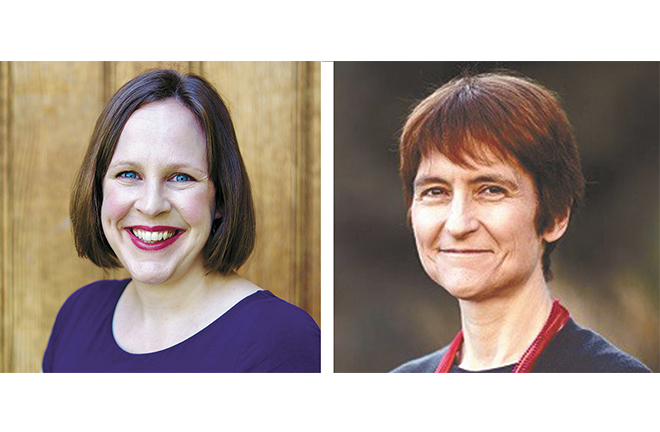Leveraging storylistening to improve public reasoning

Sarah Dillon (Left) and Claire Craig (Right) Photos: PROVIDED TO CSST
In contentious areas such as climate change and artificial intelligence, public reasoning is influenced by the quality of public knowledge. By analyzing the role of stories as narrative evidence in those areas, Sarah Dillon, a professor of literature at the University of Cambridge, and Claire Craig, the provost of Queen’s College at the University of Oxford, make the case for leveraging stories in order to improve public reasoning and for reimagining what public humanities mean. Their co-authored book Storylistening: Narrative Evidence and Public Reasoning was published by Routledge in February.
Definitions
“We see an urgent need to reassess the value, power, and importance of stories in light of major recent social and political events, such as the financial crisis, the COVID-19 pandemic, and the Brexit referendum,” Craig said. The book Storylistening draws together insights about the interactions between stories and human actions to demonstrate how stories can inform public reasoning and decision-making.
“Story” is here defined as a causal account of an occurance that includes entities with agency, that can be distributed or shared, and in which both form and content generate affect and cognition. Stories can be textual or non-textual.
Narrative evidence is the product of the expert act of both direct critical engagement with stories, and critical engagement with others’ story-imbibing. Critical engagement means explicit observation, analysis, and reflection. Storylistening is the theory and practice of gathering narrative evidence to inform decision-making, especially in relation to public reasoning. Narrative evidence is the result of storylistening and part of a pluralistic evidence base.
The definition of public reasoning is taken from the work of Sheila Jasanoff, who is a professor of science and technology studies at Harvard University. In her book Science and Public Reason, she defines public reasoning as the “institutional practices, discourses, techniques, and instruments through which modern governments claim legitimacy in an era of limitless risks—physical, political, and moral.”
Functions of stories
Craig and Dillon focus on four cognitive functions of stories, in particular in relation to systems and collectives rather than individuals. The first function is to provide new points of view to inform the framing of a policy debate and of the systems important to it. For instance, many stories about alien intelligence convey the breadth of ways intelligence may be redefined in the light of new technologies such as machine learning. Some stories explore social engagement with distributed intelligence, rather than superficially fixating on potential humanoid entities.
Through stories’ function in the creation of collective identities, storylistening enables new ways to explore what those identities are and what they mean. For example, storylistening illustrates collective characteristics of researchers in a particular field, showing how stories, identities, and research questions intertwine, with implications for the directions of research and technologies as well as the make-up of fields.
The modeling function of stories enables explanation and understanding. On the one hand, stories play a part in the creation and use of non-narrative models. There are storyline approaches to computational modeling of extreme weather events, and stories can act as part of scientific models in areas such as climate change, economics, and epidemiology. On the other hand, stories also function as narrative models in their own right. For instance, the American writer Kim Stanley Robinson envisions in his novel Aurora a model of social and behavioral conditions for a zero-waste world, exploring not just how to balance material cycles but what kinds of governance and skills might be needed.
Stories may be the only way of collectively thinking through the potential behaviors of complex systems in some cases. Stories do not provide scientific knowledge, but narrative evidence enables surrogative reasoning about things about which there is no scientific knowledge. Stories also offer alternative approaches to, and perspectives on, subjects also known through scientific means.
Finally, stories contribute to new forms of anticipation. In the 1990s the American writer Don DeLillo and others anticipated the financial fragility that became manifest in the 21st century. On the Beach (1957), an apocalyptic novel written by the British writer Nevil Shute, depicts a chilling scene: a small group of survivors await in the Southern Hemisphere the arrival of deadly radioactive dust spreading towards them from the Northern Hemisphere which has been destroyed by nuclear weapons during the third World War. This novel indirectly helped shape the attitude of the international community towards nuclear weapons in the 1960s, with the Partial Nuclear Test Ban Treaty signed in 1963.
Benefits and risks
“The aim of the book is to empower people to listen more critically and more carefully to existing stories,” Craig noted. The unique benefits of storylistening to public reasoning include finding new ways to reason in important areas where scientific evidence may not be sufficient, such as with respect to complex systems, times or points of extreme disruption, or areas of reasoning concerned with social and cultural matters as well as physical, technical, or engineering systems. In all cases, narrative evidence needs to be created and used in ways which complement scientific evidence and lead to stronger modes of public reasoning.
The risks associated with stories’ powerful and persuasive effects, and the potential for them to be misused or to have unruly consequences, already exist. Storylistening is about new ways to manage those risks, enabling better understanding of both truth and untruth. “Some people may be concerned that narrative evidence risks distorting, undermining, or replacing scientific evidence. To avoid this, we are clear that narrative evidence must be part of a plural evidence base,” Craig concluded.
